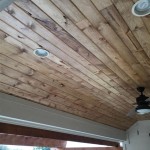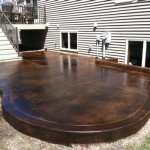How To Refinish an Old Concrete Patio
An old concrete patio, once a welcoming outdoor space, can often succumb to the elements and wear and tear, resulting in cracks, discoloration, and an overall unsightly appearance. Refinishing a concrete patio offers a cost-effective alternative to replacement, restoring its aesthetic appeal and extending its lifespan. The process, while potentially labor-intensive, is manageable for the DIY enthusiast with the proper tools, materials, and understanding of the necessary steps. This article outlines the comprehensive process of refinishing an old concrete patio, providing detailed instructions and helpful tips to ensure a successful project.
Before embarking on the refinishing process, a thorough assessment of the existing patio is essential. This assessment will determine the extent of the damage and the appropriate refinishing techniques. Surface cracks, spalling (flaking or crumbling of the concrete), and discoloration are common issues that may require specific treatment. Identifying the underlying cause of the damage, such as poor drainage or ground movement, is also crucial to prevent future problems. If the damage is extensive, involving significant structural issues, consulting with a professional concrete contractor might be necessary.
Preparation and Cleaning: The Foundation for a Successful Refinish
Proper preparation is paramount to achieving a durable and aesthetically pleasing refinished concrete patio. This stage involves thorough cleaning, crack repair, and surface profiling to ensure optimal adhesion of the new finish. Neglecting these steps can lead to premature failure of the refinishing effort, resulting in a waste of time and resources.
The first step is to remove all furniture, planters, and other items from the patio surface. Sweep the area to remove loose debris, leaves, and dirt. Next, a deep cleaning is required to eliminate stains, mold, mildew, and any existing coatings. This can be achieved using a pressure washer and a concrete cleaner specifically designed for outdoor surfaces. Follow the manufacturer's instructions for dilution and application of the cleaner. When pressure washing, maintain a consistent distance and angle to avoid damaging the concrete surface. Stubborn stains may require the application of a specialized stain remover. Grease stains, for example, may need a degreaser, while rust stains may require a rust remover.
After cleaning, inspect the patio for cracks. Small hairline cracks (less than 1/8 inch wide) can often be filled with a concrete crack filler compound. Use a trowel to apply the filler into the crack, ensuring it is flush with the surrounding surface. Allow the filler to dry according to the manufacturer's instructions. For larger cracks or structural cracks, a more robust repair method may be necessary. This might involve widening the crack with a chisel or angle grinder to create a V-shaped groove, filling the groove with a concrete patching compound, and then smoothing the surface. In cases of severe cracking or displacement, consider consulting a professional to assess the underlying structural integrity of the patio.
Surface profiling, also known as etching, is the process of creating a slightly rough surface on the concrete to improve the adhesion of the new finish. This can be achieved using an acid etching solution or a mechanical grinder. Acid etching involves applying a diluted solution of muriatic acid to the concrete surface. Always wear appropriate safety gear, including eye protection, gloves, and a respirator, when working with muriatic acid. Follow the manufacturer's instructions for dilution and application. After applying the acid, scrub the surface with a stiff brush and then rinse thoroughly with water. Ensure that all traces of acid are removed before proceeding.
Alternatively, a concrete grinder with a diamond grinding wheel can be used to mechanically profile the surface. This method is less hazardous than acid etching but requires specialized equipment. The grinder removes a thin layer of the concrete, creating a rough surface that provides excellent adhesion for the new finish. After grinding, thoroughly clean the surface to remove any dust or debris.
Selecting and Applying the Refinishing Material
The choice of refinishing material will significantly impact the final appearance and durability of the patio. Several options are available, each with its own advantages and disadvantages. These include concrete overlays, concrete stains, and epoxy coatings. Consider the desired aesthetic, budget, and level of durability when making your selection.
Concrete overlays are thin layers of cement-based material that are applied over the existing concrete surface. They can be used to create a variety of textures, patterns, and colors. Stamped overlays, for example, can mimic the look of natural stone or brick. Self-leveling overlays can be used to create a smooth, even surface. Overlays offer excellent durability and can be customized to achieve a wide range of design aesthetics. When using a concrete overlay, prime the prepared concrete surface with a bonding agent, according to the manufacturer's instructions. After the bonding agent dries, apply the overlay using a trowel or squeegee, following the recommended thickness and application techniques. For stamped overlays, use the appropriate stamps to create the desired pattern. After the overlay has cured, apply a sealant to protect it from staining and wear.
Concrete stains penetrate the surface of the concrete, creating a permanent color that won't chip or peel. Acid stains react chemically with the concrete, creating a mottled, variegated appearance. Water-based stains provide a more uniform color and are available in a wider range of shades. Stains are a relatively inexpensive and easy-to-apply option for refinishing a concrete patio. Before applying the stain, ensure the concrete surface is clean and dry. Apply the stain using a brush, roller, or sprayer, following the manufacturer's instructions. Allow the stain to penetrate the concrete for the recommended time. After the stain has dried, apply a sealant to protect it from staining and wear.
Epoxy coatings are two-part systems that create a durable, glossy finish. They are resistant to chemicals, abrasion, and staining, making them a good choice for high-traffic areas. Epoxy coatings are available in a variety of colors and can be customized with decorative flakes or metallic pigments. However, they can be more challenging to apply than other refinishing materials. Thoroughly prepare the concrete surface before applying an epoxy coating. This includes cleaning, etching, and repairing any cracks. Mix the epoxy resin and hardener according to the manufacturer's instructions. Apply the epoxy using a roller or squeegee, working in thin, even coats. Allow each coat to dry completely before applying the next. Apply a topcoat of clear epoxy or polyurethane to enhance durability and UV resistance.
Sealing and Maintenance for Long-Term Protection
Sealing the refinished concrete patio is a crucial step in protecting it from the elements, staining, and wear. A sealant creates a barrier that prevents water, oil, and other contaminants from penetrating the concrete surface. The type of sealant to use will depend on the refinishing material and the desired level of protection. Acrylic sealers are a cost-effective option that provides good protection against water and staining. Polyurethane sealers offer superior durability and UV resistance, making them a good choice for outdoor applications. Epoxy sealers provide excellent chemical resistance and are ideal for areas that are exposed to harsh chemicals or spills. Siloxane sealers penetrate the concrete surface, providing long-lasting protection against water damage and freeze-thaw cycles.
Before applying the sealant, ensure the refinished surface is clean and dry. Apply the sealant using a roller, sprayer, or brush, following the manufacturer's instructions. Apply multiple thin coats of sealant rather than one thick coat to ensure even coverage and prevent runs or drips. Allow each coat to dry completely before applying the next. Reapply the sealant every one to three years, depending on the type of sealant and the level of traffic on the patio.
Regular maintenance is essential to keeping the refinished concrete patio looking its best. Sweep the patio regularly to remove loose debris and dirt. Clean spills promptly to prevent staining. Avoid using harsh chemicals or abrasive cleaners, as these can damage the sealant and refinished surface. Periodically pressure wash the patio to remove built-up dirt and grime. Inspect the patio regularly for cracks or damage and repair them promptly to prevent further deterioration. By following these simple maintenance tips, the refinished concrete patio can provide years of enjoyment.

Resurfacing A Concrete Patio For Budget Diy Makeover Fab Everyday

3 Concrete Resurfacing Options For Patio

Resurfacing A Concrete Patio For Budget Diy Makeover Fab Everyday

Concrete Patio Resurfacing Northwest Arkansas Nwa Decorative

Concrete Resurfacing Tutorial Countertop Experts

Concrete Resurfacing Long Island Infinity Floors Best Contractor In The Tri State

5 Concrete Patio Resurfacing Ideas Skytechgeek

Concrete Stain And Sealer Patio Makeover Exchange

Concrete Patio Resurfacing Northwest Arkansas Nwa Decorative

Stamped Concrete Patio Overlays Tampa Fl
Related Posts








